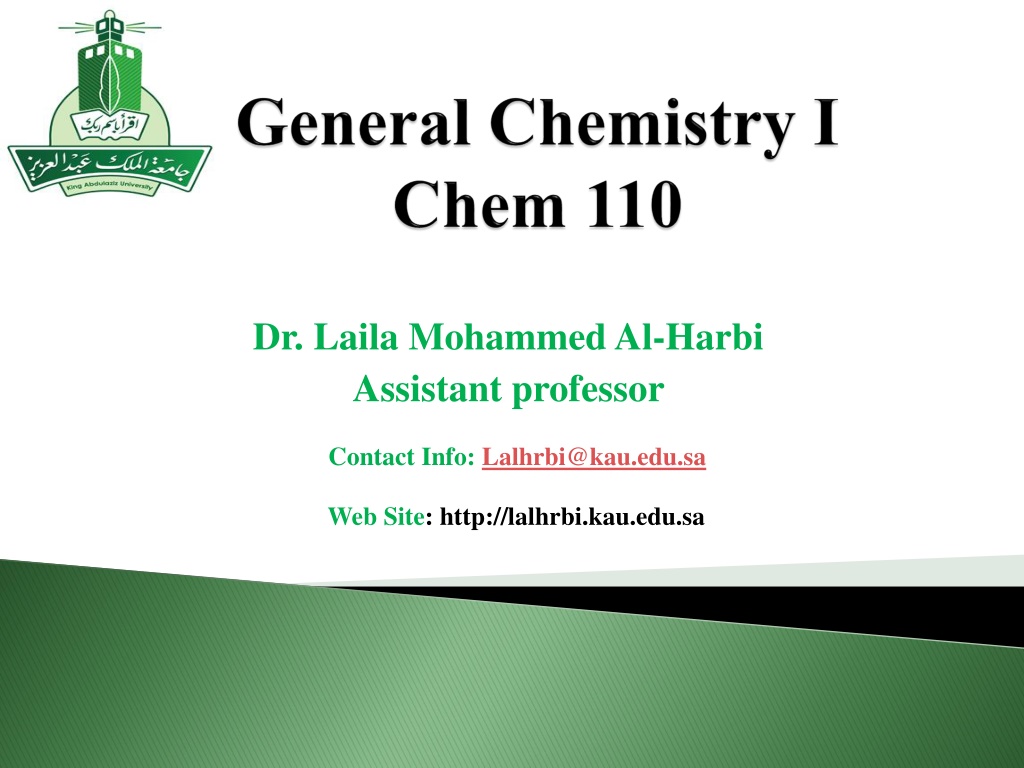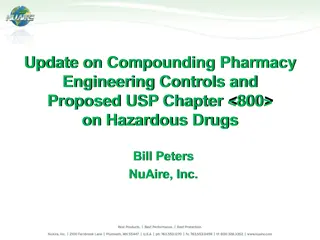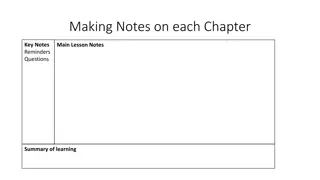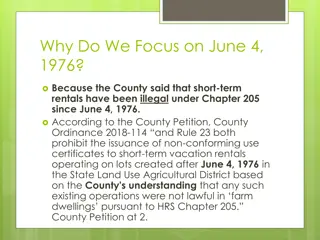
Chemistry Course Overview by Dr. Laila Al-Harbi
Dr. Laila Al-Harbi, an Assistant Professor, provides an overview of the CHEM 110 course in General Chemistry I. The course covers fundamental principles in chemistry, including significant figures, stoichiometry, atomic structure, bonding, and more. Students will gain basic knowledge essential for careers in chemistry, science, health professions, or engineering. The course structure, exam schedule, textbook recommendations, and essential topics are detailed in this comprehensive overview.
Download Presentation

Please find below an Image/Link to download the presentation.
The content on the website is provided AS IS for your information and personal use only. It may not be sold, licensed, or shared on other websites without obtaining consent from the author. Download presentation by click this link. If you encounter any issues during the download, it is possible that the publisher has removed the file from their server.
E N D
Presentation Transcript
Dr. Laila Mohammed Al-Harbi Assistant professor Contact Info: Lalhrbi@kau.edu.sa Web Site: http://lalhrbi.kau.edu.sa
Locations: Science tower 07 room 173 first floor phone 6400000 ext. 23024 email Lalhrbi@kau.edu.sa web site: http://lalhrbi.kau.edu.sa Exam schedule: 1st exam : from lecture 1-11 ( Chapters 1-4) = 30 marks 2nd exam: from lecture 12-24 (Chapters 5,7-9) = 30 marks Final exam: from lecture 1-33 = 40 marks (Chapters 1,2,3,4,5,7,8,9,10,14,15,24,25) Dr. LAILA AL-HARBI
CHEM 110 No. of Units Pr. - 1 Course No. Course Title Pre-requisites Th. 3 Credit 3 Chem 110 General Chemistry I - Course Objectives: The course aims to introduce students to basic knowledge and principle in chemistry. Course Description : It provides an introduction to the general principles of chemistry for students planning a professional career in chemistry, a related science, the health professions, or engineering. By the end of this course the student will be able to understand the following: Significant figures, scientific notation and units, stoichiometry, atomic structure & periodic table, chemical bonding, gases, ionic equilibrium, basic principles of organic and basic principles of biochemistry . Main text books: Chemistry, by Chang, 10th. ed., 2007, McGraw-Hill. Chemistry, by Steven S. Zumdahl, 6th ed., Houghton Mifflin College Div. Subsidiary books: Chemistry, by Mortimer, 6th ed., Wadsworth Inc. Dr. LAILA AL-HARBI
CHEM 110 Main text book : Chemistry, by Chang, 10th. ed., 2007, McGraw- Hill. Dr. LAILA AL-HARBI
Measurement SI units Mass and weight Volume Temperature scales Dr. LAILA AL-HARBI
By the end of this chapter you should: Know the 7 SI basic units and their prefixes. Be able to convert from one unit to other. Know to derive units from the 7 SI basic units. Know the temperature Scales Dr. LAILA AL-HARBI
Chemistry is the study of matter and the changes it undergoes There are three states of matter gas liquid solid Dr. LAILA AL-HARBI
used for commerce and science around the world Dr. LAILA AL-HARBI
Examples The SI unit of mass is The Kg is the SI unit of (a) The pound (a) length (b) The gram (b) mass (c) The kilogram (c) temperature (d) The mole (d) current 9
1m Dr. LAILA AL-HARBI
A) use numerical line B) use transfer factor ) ( . Dr. LAILA AL-HARBI
1012 1012 109 109 106 106 103 103 102 10 p m n SI K c M G T d 103103103 10 10 103 10 103 103 103 , . ) ( Dr. LAILA AL-HARBI
Convert 134 pm to m? I. II. How many meters are in 134 pm? 1 pm = 1 10-12 m 134 pm = ?? m 134 1 10-12 m = 1.34 10-10 m Dr. LAILA AL-HARBI
A measurement system is a set of units which can be used to specify anything which can be measured. This mean 1 Tm= 1x1012 m so x Tm= 1m 1m= 1x1/ 1x1012 1m = 1x10-12 To make this calculation 1x1012 In calculator press 1 then exp It can be used to any SI units i.e., 1Tg = 1x1012 g 1Ts = 1x1012 s then then 12 not 1 then x then 10 then exp then then 12 Dr. LAILA AL-HARBI
The SI prefixes giga and micro represent, respectively: A. 10-9 and 10-6. B. 106 and 10-3. C. 103 and 10-3. D. 109 and 10-6. The SI unit of mass is (a). The pound (b). The gram (c). The kilogram (d). The mole. Dr. LAILA AL-HARBI
How many microseconds are in a second? (a). 1 x 10-1 (b). 1 x 10-6 (c). 1 x 10-15 (d). 1 x 10 6 Explanation: Since the prefix micro means 1 x 10-6, there will be 1 x 10 + 6microseconds in one second. 1 s= 1 x 10 -6 s x s = 1 s s s 1 x 10 6 1 x 10 6 s Dr. LAILA AL-HARBI
Which of the following is the smallest distance? (a) 21 m 21m (b) 2.1 x 102cm 2.1m (c) 21 mm 0.021 m (d) 2.1 x 104 pm 2.1 x 10-8 m Put all of them in the same unit Explanation: Even though 2.1 x 104 is the largest number in this question, the units of pm (picometers) are the smallest units here, making it the smallest distance. Dr. LAILA AL-HARBI
A) 6.0 km is how many micrometers? Solution 1 m 1 km = 103 m km 6 km = x = 6 103 m 1 m = 1 10-6 m 109 6 6 109 x = 6 103 m x = 6 109 m Explanation: convert first to meter then from meter to micro ( two steps solution ) Dr. LAILA AL-HARBI
Example The diameter of an atom is approximately 1 10-7 mm. What is this diameter when expressed in nanometers? A. 1 10-18 nm B. 1 10-15 nm C. 1 10-9 nm D. 1 10-1 nm Example Which of these quantities represents the largest mass? A. 2.0 102 mg B. 0.0010 kg C. 1.0 105 g D. 2.0 102 cg Put all of them in the same unit A) 0.2 g B)1 g C) 0.1 g D) 2 g = 1 10-7 1 106 = 1 10-1 nm = 0.1 nm Dr. LAILA AL-HARBI
are defined in terms of the seven base quantities via a system of quantity equations. The SI derived units for these derived quantities are obtained from these equations and the seven SI base units. For example Area = width x length Unit of width = m Unit of length =m Unit of Area = m m = m2 Treat units like numbers Dr. LAILA AL-HARBI
Volume Volume = width length heights = m m m = m3 SI derived unit for volume is cubic meter (m3) Common unit of volume is liter (L) and milliliter (ml) The relation ship between liter (L) and ml (1L= 1000mL) The relation ship between liter (L) and metric system 1 L = 1 dm3 The relation ship between milliliter (ml) and metric system 1 mL = 1 cm3 1 dm3 = (1 x 10-1 m)3 = 1 x 10-3 m3 1 cm3 = (1 x 10-2 m)3 = 1 x 10-6 m3 Dr. LAILA AL-HARBI
How many cubic centimeters are there in exactly one cubic meter? The diameter of an atom is approximately 1 10-7 mm. What is this diameter when expressed in nanometers? A. 1 10-6 cm3 B. 1 10-3 cm3 C. 1 10-2 cm3 D. 1 106 cm3 Solution (1m )3 = (cm)3 1m3 = (1 102)3 cm 3 1m3 = 1 106 cm3 A. 1 10-18 nm B. 1 10-15 nm C. 1 10-9 nm D. 1 10-1 nm Dr. LAILA AL-HARBI
Mass is the measure of the amount of matter in an object. SI unit of mass is the kilogram (kg) 1 kg = 1000 g = 1 x 103 g Weight is the measurement of the pull of gravity on an object. weight = c x mass The Mass of an object doesn't change when an object's location changes. Weight, on the other hand does change with location. Chemist are interested primarily in mass The weight of man on earth is 50 pounds. is 8.25 pounds on moon Dr. LAILA AL-HARBI
Density is defined as the amount of matter in a given amount of space. mass volume density = d = m/V SI derived unit for density is kg/m3 1 g/cm3 = 1 g/mL = 1000 kg/m3 Density is intensive property Density decrease with temperature Unit of density is Kg/L g/ml )g/cm3 for liquid and solids g/L = 0.001g/ml for gases Because density of gases are very low The density of copper is 8.94 g/cm3. Dr. LAILA AL-HARBI
Given Given Given m & V m & d V & d ? d ? V ? m d = m/V V = m /d m = d x V 25
A piece of Gold metal has a volume of 15.6 cm3, with a mass of 301 g What is its density? A piece of platinum metal with a density of 21.5 g/cm3 has a volume of 4.49 cm3. What is its mass? m V d = m V d = m = d x V 301 g/ 15.6 cm3 = 19.3 g/ cm3 = 21.5 g/cm3 x 4.49 cm3 = 96.5 g Dr. LAILA AL-HARBI
The density of sulfuric acid is 1.41 g/mL has a volume of 242 mL. What is its mass? The density of mercury is 13.6 g/mL has a volume of 5.50 mL. What is its mass? m V m = d x V d = m V d = = 13.6 g/mL x 5.50 mL = 74.8 g m = d x V = 1.41 g/mL x 242 mL = 341.22 g Dr. LAILA AL-HARBI
Fahrenheit F F = [ (9/5) C] + 32 Celsius C C = (5/9) ( F - 32) Kelvin K K = C + 273.15 Dr. LAILA AL-HARBI
Temperature Units Conversion 1. Degrees Celsius 0C: Scale 0 100 Thus: 100 divisions or 100 degrees 2. Kelvin K: Scale 273 373 Thus: 100 divisions or 100 degrees 1K = 1 C 3. Degrees Fahrenheit 0F : Scale from 32 212 Thus: 180 divisions or 180 degrees Thus: the size of degree in 0F scale is only 100/180 or 5/9 of a degree on the 0C scale 10F = (5/9) 10C 29
Convert 224 0C to degrees Fahrenheit? F = (9 0F /5 0C) C + 32 [ F = (9 0F /5 0C) 224 C] + 32 0C = 435 0F Convert -452 0F to degrees Celsius. C = (5 0C /9 0F) ( F - 32 0F) C = (5 0C /9 0F) (-452 F - 32 0F) = -269 0C Convert -38.9 0C to degrees Kelvin.. K = [-38.9 C + 273.15 C ] 1 K/ 1 0C = 234.3 K Dr. LAILA AL-HARBI
Ammonia boils at -33.4C. What temperature is this in F? A. -60.1 F B. -92.1 F C. -28.1 F D. +13.5 F F = (9 0F /5 0C) C + 32 [ F = (9 0F /5 0C) -33.4 C] + 32 0C = - 28.1 0F Dr. LAILA AL-HARBI













